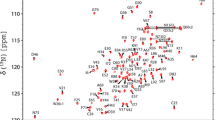Abstract
Tryparedoxin (Tpx) is a pivotal protein in the redox-metabolism of trypanosomatid parasites. Tpx has previously been identified as a potential target for drug development in the fight against human African sleeping sickness caused by Trypanosoma brucei. Tpx belongs to the thioredoxin superfamily and acts as an oxidoreductase in the parasite’s cytoplasm. It contains a WCPPC active site motif, which enables the protein to undergo thiol-disulfide exchange. To promote future protein-drug interaction analyses, we report the 1H, 13C and 15N backbone chemical shift assignments for both the oxidized and reduced states of Tpx. The redox state of the protein has a significant impact on the chemical shifts of the residues at the active site of the protein, especially on the two redox active site cysteines. The NMR assignments presented here will be a prerequisite for investigating drug binding to Tpx in molecular detail and to drive further drug optimization.


Similar content being viewed by others
References
Alphey MS, Leonard GA, Gourley DG, Tetaud E, Fairlamb AH, William NH (1999) The high resolution crystal structure of recombinant Crithidia fasciculata tryparedoxin-I. J Biol Chem 274(36):25613–25622
Alphey MS, Gabrielsen M, Micossi E, Leonard GA, McSweeney SM, Ravellis RBG, Tetaud E, Fairlamb AH, Bond CS, Hunter WN (2003) Tryparedoxins from Crithidia fasciculata and Trypanosoma brucei. J Biol Chem 278(28):25919–25925
Berriman M et al (2005) The genome of the african trypanosome Trypanosoma brucei. Science 309:416–422
Brun R, Blum J, Chappuis F, Burri C (2009) Human African trypanosomiasis. The Lancet 375:148–159
Fueller F, Jehle B, Putzker K, Lewis JD, Krauth-Siegel RL (2012) High throughput screening against the peroxidase cascade of African trypanosomes identifies antiparasitic compounds that inactivate Tryparedoxin. J Biol Chem 287(12):8792–8802
Hofmann B, Bude H, Bruns K, Guerrero SA, Kalisz HM, Menge U, Montemartini M, Nogoceke E, Steinert P, Wissing JB, Flohé L, Hecht HJ (2001) Structures of tryparedoxins tevealing interaction with trypanothione. Biol Chem 382:459–471
Keller RLJ (2004) The computer aided resonance assignment tutorial. CANTINA Verlag, Goldau
Krauth-Siegel RL, Leroux AE (2012) Low-molecular-mass antioxidants in parasites. Antioxid Redox Signal 17(4):583–607
Krumme D, Budde H, Hecht HJ, Menge U, Ohlenschläger O, Ross A, Wissing J, Wray V, Flohé (2003) NMR Studies of the interaction of tryparedoxin with redox-inactive substrate homologues. BioChemistry 42:14720–14728
Lüdemann H, Dormeyer M, Sticherling C, Stallmann D, Follmann H, Krauth-Siegel RL (1998) Trypanosoma brucei tryparedoxin, a thioredoxin-like protein in African trypanosomes. FEBS Lett 431:381–385
McCall LI, McKerrow JH (2014) Determinants of disease phenotype in trypanosomatid parasites. Trends Parasitol 30(7):342–349
Muchmore DC, McIntosh LP, Russell CB, Anderson DE, Dahlquist FW (1989) Expression and nitrogen-15 labeling of proteins for proton and nitrogen-15 nuclear magnetic resonance. Methods Enzymol 177:44–73
Mulder FAA, Schipper D, Bott R, Boelens R (1999) Altered flexibility in the substrate-binding site of related native and engineered high alkaline Bacillus subtilisins. J Mol Biol 292:111–123
Sattler M, Schleucher J, Griesinger C (1999) Heteronuclear multidimensional NMR experiments for the structure determination of proteins in solution employing pulsed field gradients. Prog Nucl Magn Reson Spectrosc 34:93–158.
Schlecker T, Comini MA, Melchers J, Ruppert T, Krauth-Siegel RL (2007) Catalytic mechanism of the gluthathione peroxidase-type tryparedoxin peroxidase of Trypanosoma brucei. Biochem J 405:445–454
Acknowledgements
Research in the UAH lab is supported by the Carl Zeiss Foundation and the Centre for Biomolecular Magnetic Resonance (BMRZ), Goethe University Frankfurt, funded by the state of Hesse. The work of LKS is funded by the DFG (SPP 1710 and Kr1242/5-1). We thank Benedikt Goretzki for fruitful discussions and members of the BMRZ for technical support.
Author information
Authors and Affiliations
Corresponding author
Rights and permissions
About this article
Cite this article
Wagner, A., Diehl, E., Krauth-Siegel, R.L. et al. Backbone NMR assignments of tryparedoxin, the central protein in the hydroperoxide detoxification cascade of African trypanosomes, in the oxidized and reduced form. Biomol NMR Assign 11, 193–196 (2017). https://doi.org/10.1007/s12104-017-9746-7
Received:
Accepted:
Published:
Issue Date:
DOI: https://doi.org/10.1007/s12104-017-9746-7




